Scottish National Gallery
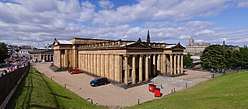 National Gallery of Scotland and Royal Scottish Academy Building, viewed from the South (2005) | |
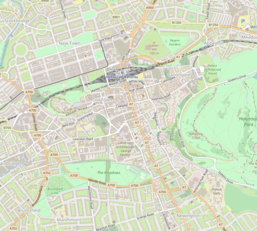 Location within Edinburgh city centre | |
| Former name | National Gallery of Scotland |
|---|---|
| Established | 1859 |
| Location |
The Mound Edinburgh Scotland |
| Coordinates | 55°57′3.24″N 3°11′44.38″W / 55.9509000°N 3.1956611°WCoordinates: 55°57′3.24″N 3°11′44.38″W / 55.9509000°N 3.1956611°W |
| Visitors |
1,600,761 (2017)[1] |
| Public transit access |
|
| Website |
www |
The Scottish National Gallery (formerly the National Gallery of Scotland) is the national art gallery of Scotland. It is located on The Mound in central Edinburgh, close to Princes Street. The building was designed in a neoclassical style by William Henry Playfair, and first opened to the public in 1859.[3]
The gallery houses Scotland's national collection of fine art, spanning Scottish and international art from the beginning of the Renaissance up to the start of the 20th century.
The Scottish National Gallery is run by National Galleries of Scotland, a public body that also owns the Scottish National Gallery of Modern Art and the Scottish National Portrait Gallery. Because of its architectural similarity, the Scottish National Gallery is frequently confused by visitors with the neighbouring Royal Scottish Academy Building (RSA), a separate institution which works closely with the Scottish National Gallery.[4]
History
.jpg)
The origins of Scotland's national collection lie with the Royal Institution for the Encouragement of the Fine Arts in Scotland, founded in 1819. It began to acquire paintings, and in 1828 the Royal Institution building opened on The Mound. In 1826, the Scottish Academy was founded by a group of artists as an offshoot of the Royal Institution, and in 1838 it became the Royal Scottish Academy (RSA). A key aim of the RSA was the founding of a national collection. It began to build up a collection and from 1835 rented exhibition space within the Royal Institution building.[3]
In the 1840s, plans were put in place for a new building to house the RSA.[3] The noted Scottish architect William Henry Playfair was commissioned to prepare designs, and on 30 August 1850, Prince Albert laid the foundation stone.[5] The building was originally divided along the middle, with the east half housing the exhibition galleries of the RSA, and the western half containing the new National Gallery of Scotland,[5] formed from the collection of the Royal Institution.[3] In 1912 the RSA moved into the Royal Institution building, which remains known as the Royal Scottish Academy Building. When it re-opened, the gallery concentrated on building its permanent collection of Scottish and European art for the nation of Scotland.
In the early 21st century, the National Galleries launched the Playfair Project, a scheme to create a new basement entrance to the National Gallery in Princes Street Gardens and an underground connecting space, called the Weston Link, between the Gallery and the renovated Royal Scottish Academy Building building. The new underground space opened in 2004.[6]
In 2012, the gallery's umbrella organisation, National Galleries of Scotland, underwent a rebranding exercise, and National Gallery of Scotland was renamed the Scottish National Gallery.[7][8]
The building
William Playfair's building — like its neighbour, the Royal Scottish Academy — was designed in the form of an Ancient Greek temple atop a stylobate steps. While Playfair designed the RSA in the Doric order, the National Gallery building was surrounded by Ionic columns topped with tetrastyle porticoes. The pair of porticoes at the main entrance reflect the building's original dual purpose, to house the two collections of the NGS and the RSA, and these originally served as two separate entrances.[4][9][5]
Playfair worked to a much more limited budget than the RSA project, and this is reflected in his comparatively austere architectural style. He may have drawn inspiration from an 1829 scheme for an arcade of shops by Archibald Elliot II, son of Archibald Elliot. Playfair's National Gallery was laid out in a cruciform plan; he originally planned to build towers at the corners of the transverse central block, but these were abandoned during the project. When the RSA moved into the former Royal Institution building in 1912, the English architect William Thomas Oldrieve was engaged to remodel the NGS interior to house the National Gallery collection exclusively.[9]
In the 1970s, when the gallery was under the direction of the Department of the Environment, the building was extended. An upper floor was added at the south end in 1972, creating five new small galleries, and in 1978 a new gallery was opened in the basement to house the Gallery's Scottish Collection.[9][10]
The new Princes Street Gardens entrance and underground space opened in 2004 was designed by John Miller and Partners. Construction took five years and cost £32 million. The area contains a lecture theatre, education area, shop, restaurant, an interactive gallery, and a link to the RSA building.[3][11]
- Architectural features
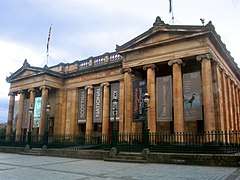 Twin porticoes at the main entrance with the original name inscribed on the pediment
Twin porticoes at the main entrance with the original name inscribed on the pediment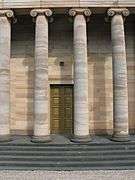 Playfair's ionic columns
Playfair's ionic columns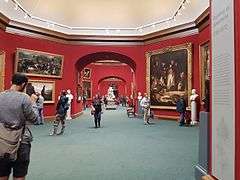 Interior of the ground floor main galleries
Interior of the ground floor main galleries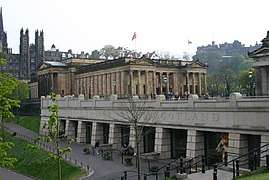 The Princes Street Gardens entrance (opened 2004)
The Princes Street Gardens entrance (opened 2004)
Research
The research facilities at the Scottish National Gallery include the Prints and Drawings Collection of over 30,000 works on paper, from the early Renaissance to the late nineteenth century; and the reference-only Research Library. The Research Library covers the period from 1300 to 1900 and holds approximately 50,000 volumes of books, journals, slides, and microfiches, as well as some archival material relating to the collections, exhibitions and history of the National Gallery. The Print Room or Research Library can be accessed by appointment.
Collection
| Wikimedia Commons has media related to: |
At the heart of the National Gallery's collection is a group of paintings transferred from the Royal Scottish Academy Building. This includes masterpieces by Jacopo Bassano, Van Dyck and Giambattista Tiepolo. The National Gallery did not receive its own purchase grant until 1903.
In the Gallery's main ground floor rooms are displayed a number of major large-scale canvases such as Benjamin West's Alexander III of Scotland Rescued from the Fury of a Stag (1786), Rubens's The Feast of Herod (1633 or c.1637-38) and a pair of paintings by Titian, Diana and Actaeon and Diana and Callisto (purchased jointly with the National Gallery, London). The Scottish National Gallery has also jointly acquired one of Canova's sculptures of The Three Graces with the Victoria and Albert Museum.[12]
The Scottish National Gallery has a notable collection of works by Scottish artists, including several landscapes by Alexander Nasmyth, and several works by Sir Henry Raeburn — of particular note his portraits of Alexander Ranaldson Macdonell and Sir Walter Scott), and his celebrated painting, The Skating Minister. There are also a number of works by artists of the Glasgow School such as James Guthrie. The Gallery also holds a collection of works by English painters, such as Constable's Dedham Vale and a sizeable collection of water colours by Turner which are traditionally displayed in January. The Monarch of the Glen, a painting considered to be iconic of Scottish culture, is also held in the gallery, the work of the English painter Landseer.[12]
Notable works
Key works of art displayed at the National Gallery include:
- Gian Lorenzo Bernini, Carlo Antonio dal Pozzo and Design for a Papal Monument
- Sandro Botticelli, Virgin Adoring the Sleeping Christ Child
- Antonio Canova, The Three Graces (displayed on rotation with the Victoria and Albert Museum in London)
- Paul Cézanne, The Big Trees and Montagne Sainte-Victoire
- Giambattista Pittoni, St Jerome and Peter of Alcantara
- Jean Siméon Chardin, Vase of Flowers
- John Constable, Dedham Vale
- Gerard David, Three Legends of St Nicholas
- Edgar Degas, Portrait of Diego Martelli
- James Drummond, The Porteous Mob and A Lady Descending from a Sedan Chair. Study for the Painting The Porteous Mob[13]
- Anthony van Dyck, The Lomellini Family
- Thomas Gainsborough, The Hon. Mrs Graham
- Paul Gauguin, Vision after the Sermon
- Hugo van der Goes, The Trinity Altarpiece (on loan from the Royal Collection)
- Francisco de Goya, El Medico (painting)|El Medico
- El Greco, Saint Jerome in Penitence
- El Greco, Fábula
- El Greco, Christ Blessing (The Saviour of the World)
- Gavin Hamilton, Dawkins and Wood Discovering the Ruins of Palmyra
- Dominique Ingres, Mlle Albertine Hayard
- Claude Monet, Haystacks
- Nicolas Poussin, The Seven Sacraments
- Sir Henry Raeburn, The Reverend Robert Walker Skating on Duddingston Loch
- Allan Ramsay, Margaret Lindsay
- Raphael, Bridgewater Madonna
- Rembrandt van Rijn, A Woman in Bed and Self-Portrait
- Sir Joshua Reynolds, The Ladies Waldegrave
- Pieter Jansz Saenredam, Grote_Kerk,_Haarlem
- Georges Seurat, La Luzerne, St-Denis
- Titian, Venus Anadyomene, Diana and Callisto, Diana and Actaeon, The Virgin and Child with St John the Baptist and an Unidentified Saint, and The Three Ages of Man
- Joseph Mallord William Turner, Somer Hill and the Vaughan Bequest of 38 works
- Diego Velázquez, Old Woman Frying Eggs
- Johannes Vermeer, Christ in the House of Martha and Mary
- Antoine Watteau, Fêtes venetiènnes
- Notable artworks in the Scottish National Gallery collection
 Holy Family with a Palm Tree
Holy Family with a Palm Tree
(Raphael, 1506)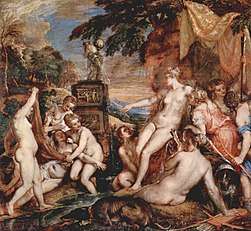
_-_Google_Art_Project.jpg) The Hon. Mrs Graham
The Hon. Mrs Graham
(Thomas Gainsborough, 1775)
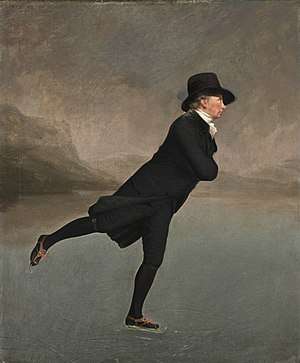
 Dedham Vale
Dedham Vale
(John Constable, 1802) Niagara Falls, from the American Side
Niagara Falls, from the American Side
(Frederic Edwin Church, 1867)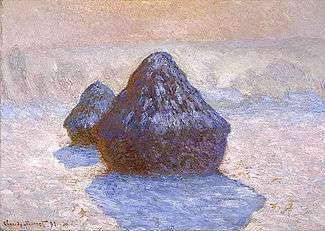
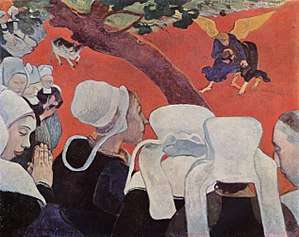
Other artists represented in the collection include:
- David Allan
- Francis Bacon
- Federico Barocci
- William Blake
- David Young Cameron
- Gustave Courbet
- Aelbert Cuyp
- Eugène Delacroix
- Domenichino
- Albrecht Dürer
- William Dyce
- Adam Elsheimer
- John Emms[14]
See also
References
- ↑ "2017 Visitor Figures". Association of Leading Visitor Attractions. Retrieved 22 March 2018.
- ↑ Latest Visitor Figures, ALVA, 2014. Retrieved on 10 July 2014.
- 1 2 3 4 5 "Scottish National Gallery - History & Architecture". Archived from the original on 7 February 2014. Retrieved 27 January 2014.
- 1 2 Campbell, Donald (2003). Edinburgh: A Cultural and Literary History. Signal Books. ISBN 9781902669731. Retrieved 12 April 2018.
- 1 2 3 "Listed building details (number=27679) 1 The Mound, National Gallery Of Scotland with Railings". Historic Environment Scotland.
- ↑ "Playfair Project". National Galleries of Scotland. Retrieved 3 April 2012.
- ↑ Potter, MatthewC (2017). "The Concept of the 'Master' in Art Education in Britain and Ireland, 1770 to the Present ". Routledge. p. 17. ISBN 9781351545471. Retrieved 12 April 2018.
- ↑ "O Street creates unifying brands for Scottish galleries - Design Week". Design Week. 8 June 2011. Archived from the original on 12 April 2018. Retrieved 12 April 2018.
- 1 2 3 Gifford, John; McWilliam, Colin; Walker, David; Wilson, Christopher (1991). Edinburgh. Yale University Press. pp. 282–3. ISBN 0300096720. Retrieved 12 April 2018.
- ↑ "Our history". www.nationalgalleries.org. National Galleries of Scotland. Archived from the original on 12 April 2018. Retrieved 12 April 2018.
- ↑ "Opening day for gallery project". BBC News. 4 August 2009.
- 1 2 "Artworks". www.nationalgalleries.org. National Galleries of Scotland. Retrieved 13 April 2018.
- ↑ National Gallery of Scotland, James Drummond
- ↑ John Emms, National Gallery of Scotland.
External links
| Wikimedia Commons has media related to Scottish National Gallery. |